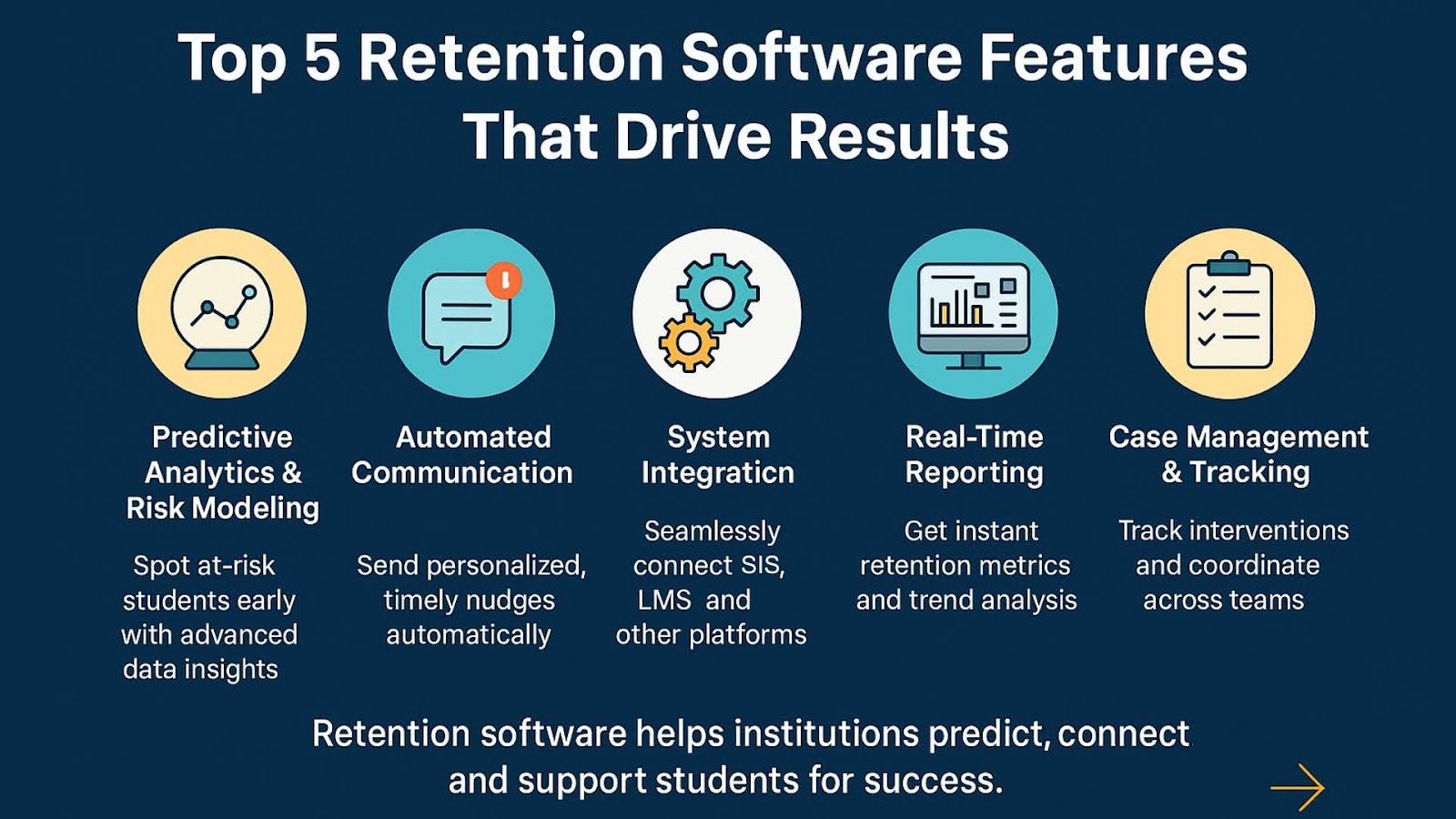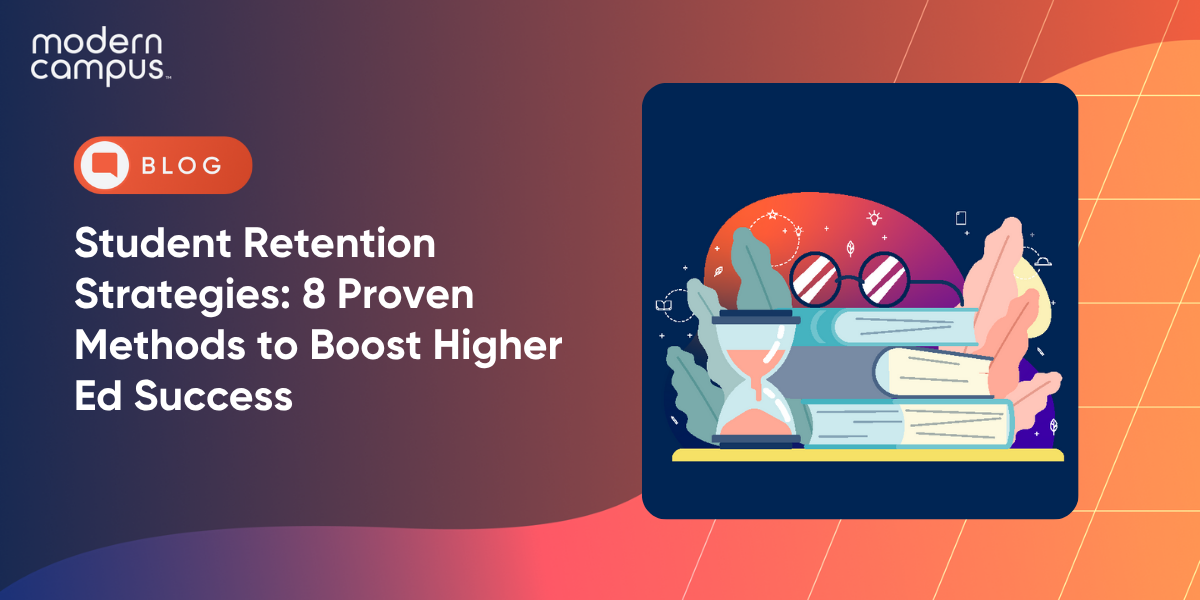Student Retention Strategies: 8 Proven Methods to Boost Higher Ed Success
Student retention has rebounded to the highest levels in a decade, reaching 76.5% nationally in 2024.
- Early warning systems with predictive analytics identify at-risk students before they struggle.
- Technology-enhanced engagement increases retention across student populations.
- Comprehensive financial support addresses the primary cause of student departure.
- Mental health integration and personalized pathways create supportive environments where students thrive.
Universities implementing comprehensive retention management software see measurable improvements in persistence rates.
Higher education is experiencing a retention renaissance. After years of declining persistence rates, 2024 data shows the highest student retention levels in over a decade. Yet nearly one in four students still don't make it past their first year, representing a challenge and opportunity for institutions willing to invest in proven student retention strategies.
Learners face unprecedented hurdles, from evolving mental health needs and changing career expectations to the need for institutions that can guide them through their entire learner-to-earner journey with personalized support and meaningful engagement.
Why Do Student Retention Strategies Matter in 2025?
Student departure creates challenges for universities across recruitment costs, lost tuition revenue and reduced institutional effectiveness. Beyond the financial implications, retention reflects an institution's ability to fulfill its fundamental promise: helping students achieve their educational and career goals.
Recent data reveals encouraging trends alongside persistent challenges. The National Student Clearinghouse reports significant improvement in persistence rates. However, disparities remain across demographics and institution types. Community colleges maintain a 55% retention rate, while four-year public institutions achieve 78% retention, highlighting the need for targeted, evidence-based interventions focused on improving retention in higher ed.
1. What Are the Most Effective Early Warning Systems for Student Success?
Modern student retention strategies begin with early warning systems that leverage predictive analytics to identify at-risk students. These systems analyze multiple data points (academic performance, attendance patterns, engagement metrics and demographic factors) to create comprehensive risk profiles that enable timely interventions.
Effective systems monitor key indicators, including GPA trends, course withdrawal rates, assignment completion patterns and attendance tracking. Financial aid status and payment patterns often predict students at risk of dropping out due to economic pressures. Social engagement data provides insight into students' connection to the institutional community.
By tracking attendance, assignment submissions and early exam performance, faculty can flag students showing signs of academic distress within the first few weeks of the semester, contributing to improved retention rates and earlier connection of students with appropriate support resources.

Successful early warning systems require institution-wide collaboration between faculty, academic advisors and student affairs professionals to coordinate wrap-around services and connect students with tutoring, counseling, financial aid and other support resources as part of comprehensive student success strategies.
2. How Does Technology-Enhanced Engagement Transform Student Retention?
Technology offers personalized, accessible touchpoints that meet learners where they are: on their mobile devices. Student engagement software platforms provide real-time communication, automated check-ins and customized content delivery that keep students connected to their academic journey.
Mobile-first engagement strategies recognize that students expect immediate, convenient access to information and support. Push notifications remind students of important deadlines and available resources. Personalized dashboards provide at-a-glance views of academic progress and involvement opportunities. Two-way messaging enables quick connections with advisors and support staff.
Valdosta State University demonstrates the impact of engagement. Students who attend at least 10 campus events per semester are 13 percentage points more likely to persist to the next semester. Gamification elements, including points-based systems, leaderboards and digital badges, further boost participation rates by rewarding engagement and academic milestones.

The key to successful technology integration lies in balancing digital convenience with human connection, ensuring that automated systems efficiently deliver information while personal interactions build the relationships that keep students enrolled and motivated.
3. What Role Do Personalized Learning Pathways Play in Student Success?
Personalized learning pathways paved the way from one-size-fits-all education to customized experiences that align with individual student goals, learning styles and life circumstances. These structured routes guide students toward their academic objectives while accommodating their unique needs and constraints.
Effective pathways incorporate academic planning tools that help students visualize course sequences and understand prerequisite relationships. Career integration connects academic choices to labor market data, showing students how their coursework translates to employment opportunities. Flexible scheduling options accommodate working students, parents and other non-traditional learners who need alternatives to traditional course formats.
The University of Arizona's personalized learning initiative demonstrates the power of individualized approaches. Students work with advisors to create customized degree plans that consider their career aspirations, existing credits and personal circumstances, leading to improved retention rates as students gain a clearer understanding of their academic trajectory and see direct connections between coursework and career goals.
Technology platforms enable institutions to scale personalized approaches through data analytics that identify patterns in student behavior and preferences, allowing for precise targeting of interventions and support services.
4. How Do Comprehensive Financial Support Programs Impact Retention?
Financial challenges remain a leading cause of student departure, with 30% of dropouts citing financial difficulties as their primary reason for leaving. Comprehensive financial support programs are a vital component of improving retention in higher ed, addressing the full spectrum of economic barriers.
Emergency financial assistance programs provide support for unexpected expenses that might otherwise force students to leave school. These funds can cover everything from car repairs and medical bills to textbook costs and housing deposits.
Financial literacy education empowers students to make informed decisions about their education investment. Workshops on budgeting, loan management and career planning help students understand the long-term value of their degree while developing practical skills for financial stability. Work-study programs and on-campus employment opportunities provide income while keeping students engaged with the institutional community.

5. Why Is Mental Health Integration Essential for Modern Retention Strategies?
Mental health challenges have become prominent factors in student departure. Institutions that integrate mental health support into their retention strategies see improved persistence rates and overall student well-being.
Comprehensive counseling services provide both crisis intervention and ongoing support for students dealing with anxiety, depression and other mental health challenges. However, effective mental health integration includes peer support programs, stress management workshops and wellness initiatives that promote overall student well-being.
Faculty and staff training programs help recognize signs of distress and connect students with appropriate resources, ensuring that mental health support reaches those who might not otherwise seek help. Campus culture initiatives that reduce stigma around mental health challenges encourage students to access support services when needed.
6. What Impact Does Co-Curricular Involvement Have on Student Persistence?
Co-curricular engagement serves as one of the strongest predictors of student retention, with research consistently showing persistence advantages for students who participate in campus activities and organizations. These experiences help students develop essential skills, build relationships and create meaningful connections to their institution.
Students who attend campus co-curricular events are 53.7% more likely to persist to the next academic year compared to their non-engaged peers. Similarly, first-year students who record at least one hour of community or volunteer service achieve a 94% retention rate, which is 22 percentage points higher than students without service involvement.
Student organizations provide benefits beyond social connection, including leadership development, service learning experiences that connect academic concepts to real-world applications and cultural groups that create communities where students can explore their identities and find peers with shared experiences.
Institutions can boost participation through virtual involvement fairs, streamlined registration processes and recognition programs. The key lies in offering diverse opportunities that appeal to different student populations, including options for working students, commuters and students with varying time availability.
7. How Do Strategic Communication Systems Improve Student Outcomes?
Communication systems use data analytics to deliver targeted, relevant messages rather than generic announcements to all students. These systems segment audiences based on academic standing, engagement patterns and demonstrated needs to maximize effectiveness.
Text messaging is particularly effective, with high open rates and immediate delivery for registration deadlines, financial aid requirements and campus events. The key lies in providing valuable, actionable information rather than overwhelming students with frequent, irrelevant messages.
Predictive analytics identify optimal timing and content for communications. Students who haven't registered for the following semester might receive targeted messages about academic planning resources, while students with declining grades could receive information about tutoring services and academic support options.
Multi-channel approaches recognize that different students prefer different communication methods (email, text messages, phone calls or in-person meetings) and track student preferences to optimize future outreach efforts.
8. What Makes First-Year Experience Programs Essential for Retention?
The first year is the most critical period for student retention, with research consistently showing that students who successfully navigate their initial year are more likely to persist to graduation. Comprehensive first-year experience programs serve as foundational student success strategies that address the academic, social and personal transitions that new students face.
Effective programs extend throughout the entire year rather than ending after orientation week. Regular check-ins, milestone celebrations and ongoing support help students navigate challenges as they arise. First-year seminars provide structured environments for developing college-level academic skills while building connections with faculty and peers.
Peer mentoring programs connect new students with successful upper-class mentors who provide guidance, support and practical advice about navigating college life. These relationships often extend beyond formal program requirements, creating lasting connections that enhance students' sense of belonging.
Living-learning communities create residential environments where students with shared academic interests live together while participating in coordinated programming, helping students form study groups, develop friendships and create support networks that enhance academic performance and social integration.
Top 5 Retention Management Software Features That Drive Results
Modern institutions increasingly rely on specialized software platforms to coordinate their retention efforts and track student progress. The most effective systems share several key features:

- Predictive Analytics and Risk Modeling: Advanced algorithms analyze multiple data sources to identify students at risk of departure, considering academic performance, engagement patterns, financial aid status and demographic factors to create comprehensive risk scores.
- Automated Communication and Outreach: Sophisticated messaging systems enable personalized, timely communication based on individual circumstances and needs, with automated triggers for students who miss classes, fail to register or show other signs of disengagement.
- Integration with Existing Systems: Effective retention software seamlessly integrates with student information systems, learning management platforms and other institutional technologies to ensure comprehensive, up-to-date data informs retention efforts.
- Real-Time Reporting and Analytics: Dashboard systems provide instant access to retention metrics, intervention outcomes and trend analysis, enabling continuous refinement of retention strategies based on actual results.
- Case Management and Intervention Tracking: Comprehensive systems allow staff to document interactions with students, track intervention outcomes and coordinate efforts across multiple departments while preventing duplicated or conflicting outreach efforts.
Real-World Success Stories: Institutions That Transformed Their Retention Rates
Coppin State University achieved remarkable retention improvements through comprehensive strategy implementation. The university increased first-year retention from 66% in 2017 to 74% in 2023 by combining early warning systems, enhanced academic support and targeted outreach programs.
University of North Carolina at Charlotte achieved its highest retention rate in 15 years by addressing systemic barriers that were frustrating students and faculty. The university's catalog wasn't searchable or optimized for mobile devices, and course approval processes were incredibly time-intensive. By implementing an electronic course approval system and creating a searchable, mobile-optimized academic catalog, UNC Charlotte reduced course and curriculum proposal time by more than half, directly contributing to improved student and faculty satisfaction.
Missouri State University demonstrated the power of targeted communication in preventing student departure. The university identified that students with a 2.5 GPA or lower were more likely to stop out, and many students were no-shows for academic advisor appointments. After email outreach largely failed, the university implemented a strategic text messaging intervention to connect at-risk students with academic advisors. This approach boosted fall-to-fall retention by one percentage point during the first year, effectively saving 32 students from stopping out.
Frequently Asked Questions About Student Retention Strategies
What is the average student retention rate in higher education? The national retention rate for 2024 reached 69.5%, with persistence rates (students continuing at any institution) at 76.5%. These represent the highest levels in nearly a decade, though significant variation exists across institution types and student demographics.
How much does poor retention cost institutions financially? While specific costs vary by institution, student departure creates financial challenges through lost tuition revenue, increased recruitment expenses and reduced operational efficiency. The financial impact underscores why retention improvement is an institutional priority.
What are the main reasons students leave college before graduating? Students often leave college because of money worries, difficulty juggling school with work or family or feeling overwhelmed by stress. Others struggle academically or realize their program isn’t the right fit. When institutions understand these challenges, they can step in with the right support to keep students on track.
How early can institutions identify students at risk of dropping out? Sophisticated early warning systems can identify at-risk students within the first few weeks of enrollment by analyzing attendance patterns, assignment submissions, engagement metrics and demographic factors, enabling proactive intervention before problems become insurmountable.
What role does technology play in modern retention strategies? Technology enables personalized communication, predictive analytics, mobile engagement and comprehensive data tracking that would be impossible to manage manually. However, successful retention strategies balance technological efficiency with meaningful human connections and support.
Building a Comprehensive Retention Strategy for Long-Term Success
Student retention strategies encompass comprehensive, technology-enhanced approaches that address the full spectrum of factors influencing student success. The most effective institutions combine early warning systems, personalized communication, financial support, mental health integration and co-curricular engagement to create environments where students thrive.
The future belongs to institutions that proactively support their students through every challenge and milestone. By leveraging modern technology, evidence-based practices and student-centered approaches, institutions can help every student achieve their educational and career goals. Modern Campus empowers institutions to deliver exactly this kind of transformative student experience through comprehensive solutions designed specifically for the learner-to-earner journey. Book a demo today and transform your retention strategy.
Last updated: November 5, 2025
